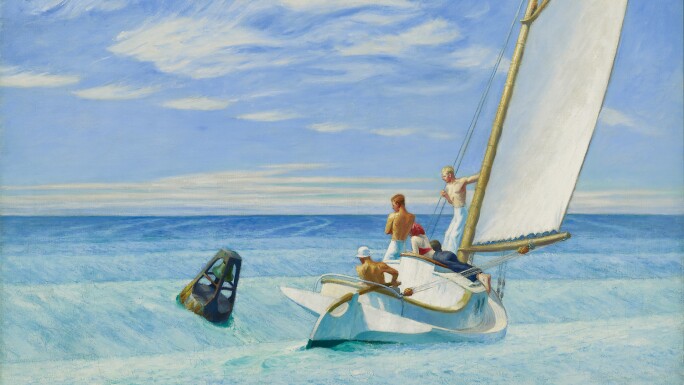Celebrated for his images of urban angst and isolation, Edward Hopper revealed his serene side in Ground Swell.

E dward Hopper was a man of the ocean, though it is often forgotten. He is, for most, an artist famed for his depictions of bars and apartments and of the lonesome and loveless enveloped in electric light. But Ground Swell, in the National Gallery of Art, Washington, shows Hopper was also a maritime artist of distinction. It is a painting that is at once pacific and sublime and seems paused on the precipice of action or danger.
Hopper was born by the water. He grew up in the shipbuilding town of Nyack on the Hudson River in New York, where as a boy he would doodle seascapes and carve wooden model boats. As an adult he would holiday, and paint, in the coastal regions of Maine and Cape Cod. “My aim in painting has always been the most exact transcription possible of my most intimate impression of nature,” he observed.
In Ground Swell Hopper depicts three young men and a woman sailing a catboat off the Massachusetts coast. Painted in 1939, as the world teetered on the edge of war, it is a crisp, but uneasy scene of sun-rays, sea-spray and the surging promise of youth.
In the 1920s, before his successful career as a painter, Hopper worked as a freelance commercial artist. His illustrations appeared in a variety of publications, including The Morse Dry Dock Dial, the monthly magazine of the Morse Dry Dock and Repair Company in Brooklyn, for which he produced a series of covers on a shipping theme. He drew yachts in dry docks, workmen riveting hulls, tall ships teetering on the crests of waves and passengers parading on deck.
Another regular client of Hopper's was the trade journal Hotel Management. For its September 1924 issue, Hopper created a cover featuring several figures in a catboat that is heeling under a full sail – a composition that he had first used in an etching two years earlier and would develop, some 15 years later, into the masterful oil painting Ground Swell.
Hopper’s tranquil ocean pictures draw enthusiastic bidding at Sotheby’s. Two were sold in our New York saleroom in 2014: Dune at Truro – a watercolor and pencil sketch of the sands surrounding the artist’s summer house on Cape Cod – achieved for $233,000, far exceeding its estimate; and Coast Guard Cove, an early watercolor painted during a visit to Cape Elizabeth, Maine, in 1929, sold for $1.08 million.
Hopper’s city works are equally sought after. Away from the sea, in the bustle of New York, his eye was drawn to more psychological subjects. This can be seen in his final work, Two Comedians, 1966. An elegiac study of two performers taking a bow on stage, it sold at Sotheby’s in 2018 for $12.49 million.








